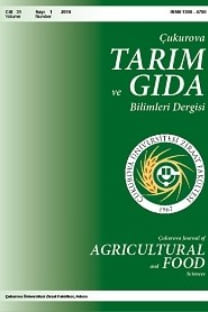Comparison of Bioactive and Antimicrobial Properties of Black and Green Teas
Black tea, green tea, antimicrobial, total phenolic content, antioxidant activity
Siyah ve Yeşil Çayların Biyoaktif ve Antimikrobiyal Özelliklerinin Kıyaslanması
Siyah çay, yeşil çay, antimikrobiyal, toplam fenolik madde, antioksidan aktivite,
___
- Brand-Williams, W., Cuvelier, M. E., and Berset, C. (1995) Use of a free radical method to evaluate antioxidant activity, LWT – Food Sci, Technol. 28: 25–30.
- Carloni, P., Tiano, L., Padella, L., Bacchetti, T., Customu, C., Kay, A., Damiani, E. (2013) Antioxidant activity of white, green and black tea obtained from the same tea cultivar. Food Res Int 53: 900–908.
- Farooqui, A., Khan, A., Borghetto, I., Kazmi, S.U., Rubino, S., Paglietti, B. (2015) Synergistic antimicrobial activity of Camellia sinensis and Juglans regia against multidrug-resistant bacteria. PLoS ONE 10: 1–14.
- Friedman, M. (2007) Overview of antibacterial, antitoxin, antiviral, and antifungal activities of tea flavonoids and teas. Mol Nutr Food Res 51: 116–134.
- Karori, S.M., Wachira, F.N., Wanyoko, J.K., Ngure, R.M. (2007) Antioxidant capacity of different types of tea products. Afr J Biotechnol 6: 2287–2296.
- Kelebek, H. (2016) LC-DAD-ESI-MS/MS characterization of phenolic constituents in Turkish black tea: Effect of infusion time and temperature. Food Chem 204: 227–238.
- Kuroda, Y., Hara, Y. (1999) Antimutagenic and anticarcinogenic activity of tea polyphenols. Mutation Research - Mutat Res Rev 436: 69–97.
- Layher, J.W., Poling, J.S., Ishihara, M., Azadi, P., Alvarez-Manilla, G., Puett, D. (2013) A possible effect of concentrated oolong tea causing transient ıschemic attack-like symptoms. Br J Med Med Res 3: 2157–2172.
- Lin, Y.S., Tsai, Y., Tsay, J.S., Lin, J.K. (2003) Factors affecting the levels of teapolyphenols and caffeine in tea leaves. J Agric Food Chem 51: 1864–1873.
- Obanda M, Owuor PO, Mang’oka R (2001) Changes in the chemical and sensory quality parameters of black tea due to variations of fermentation time and temperature. J. Food Chem. 75: 395-404
- Ozturk, I., Caliskan, O., Tornuk, F., Ozcan, N., Yalcin, H. (2015). Antioxidant, antimicrobial, mineral, volatile, physicochemical and microbiological characteristics of traditional home-made Turkish vinegars. LWT - Food Sci Technol 63: 144–151.
- Paola, R.D., Mazzon, E., Muia, C., Genovese, T., Menegazzi, M., Zaffini, R., Suzuki, H., Cuzzocrea, S. (2005) Green tea polyphenols attenuates lung ınjury in carrageean-ınduced pleurisy injury in mice. Respir Res 6: 1465–9921.
- Singleton, V.L., Rossi, J.A. (1965) Colorimetry of total phenolics with phosphomolybdic-phosphotungstic acid reagents. Am J Enol Viticult, 16:144–158
- Wang, Y., Ho, C.T. (2009) Polyphenols chemistry of tea and coffee: A century of progress. J Agric Food Chem 57, 8109–8114.
- Yam, T.S., Shah, S. Hamilton-Miller, J.M.T. (1997) Microbiological activity of whole and fractionated crude extracts of tea (Camellia sinensis), and of tea components. FEMS Microbiol Lett 152: 169–174.
- Yamamoto, Y., Matsunaga, K., Friedman, H. (2004) Protective effects of green tea catechins on alveolar macrophages against bacterial infections. Biofactors 21: 119-21.
- Yıldırım, A., Mavi, A., Oktay, M., Kara, A.A., Algur, O.F. Bilaloglu, V. (2000) Comparison of antioxidant and antimicrobial activities of Tilia (Tilia argentea Desf ex DC), sage (Salvia triloba L.), and black tea (Camellia sinensis) extracts. J Agric Food Chem 48: 5030–5034.
- Zhu, Y., Luo, Y., Wang, P., Zhao, M., Li, L., Hu, X. Chen, F. (2015) Simultaneous determination of free amino acids in Pu-erh tea and their changes during fermentation. Food Chem 194: 643–649.
- ISSN: 2636-7874
- Başlangıç: 1973
- Yayıncı: Çukurova Üniversitesi
Özkan GÜĞERCİN, Deniz Levent KOÇ, Kenan BÜYÜKTAŞ, Nafi BAYTORUN, Bekir POLAT, Özlem Derya POLAT
Kaolin Uygulamasının Cevizlerde Bazı Bitki Fizyolojik Özellikleri Üzerine Etkileri
Neslihan KILIÇ, Nurgul F. TÜREMİŞ, Celaleddin BARUTÇULAR
Comparison of Bioactive and Antimicrobial Properties of Black and Green Teas
Pınar KADİROĞLU, Sevgin DIBLAN
Süt Keçiciliğinde Somatik Hücre Sayısının Önemi ve Süt Kalitesine Etkisi
Özgül ANİTAŞ, Serap GÖNCÜ, Nazan KOLUMAN
Süs Turunçgil Bitkilerinde Turunçgil Cüceleşme Viroidi (CEVd)’nin Araştırılması
